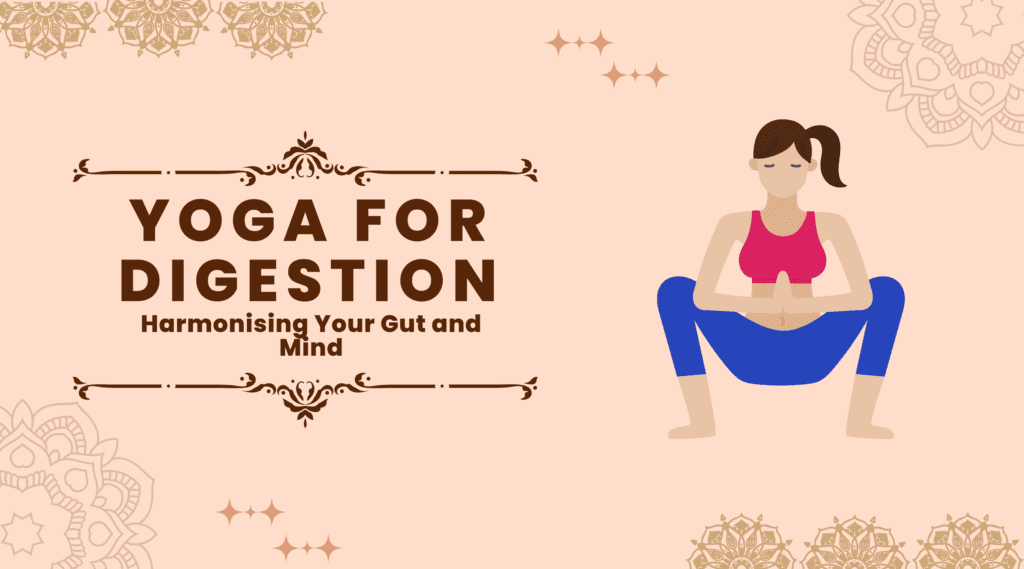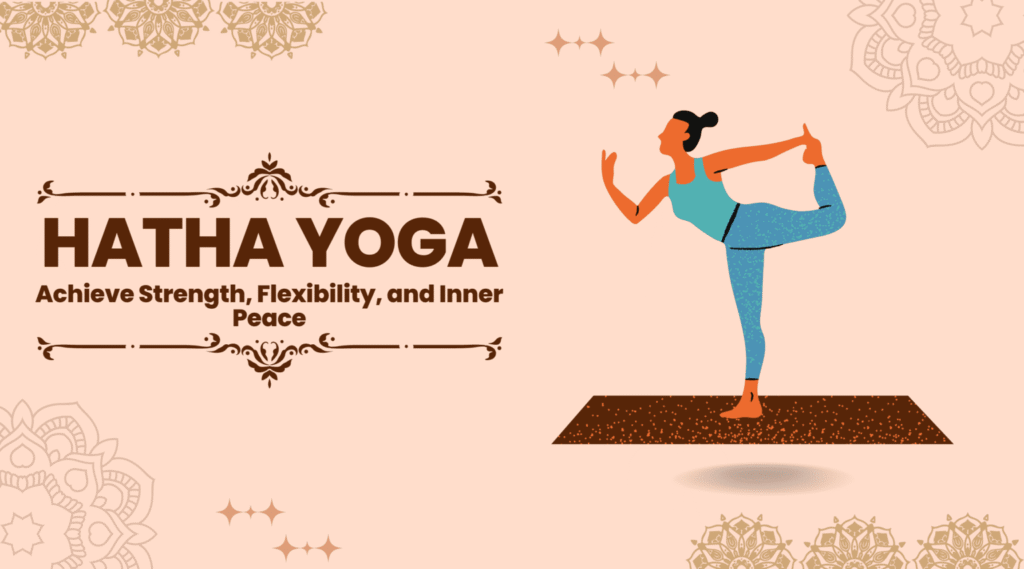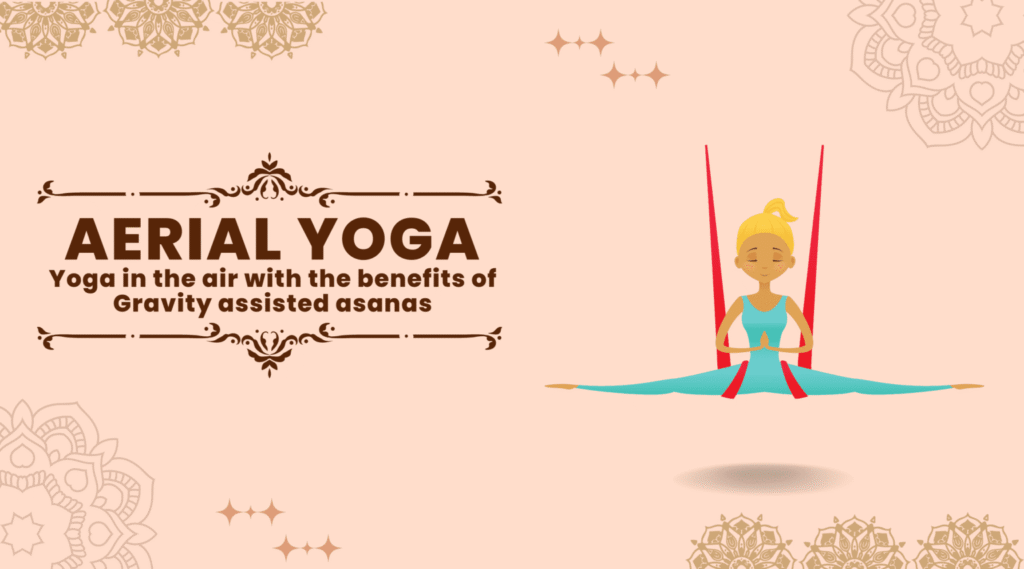
Introduction
Good digestion is essential for overall well-being. When our digestive system works on optimum efficiency, we get better nutrient absorption, increased levels of energy as well as improved overall health. But in today’s fast-paced world, digestive issues have become increasingly common. Poor dietary choices, stress, sedentary lifestyles, and irregular eating habits can wreak havoc on our digestive systems. So, in order to overcome such health conditions, yoga for digestion is a perfect option.
Yoga combines physical postures, breath control, and meditation techniques to create a holistic practice that not only benefits both the body and mind but also supports our digestion and promotes a healthy gut.
In this blog post, we will explore how yoga can improve digestion, alleviate common digestive problems as well as provide you with a sequence of yoga poses and lifestyle practices specifically designed to enhance digestion and restore balance to your gut health.
Suggested: Best Yoga Retreats And Yoga Teacher Training In Rishikesh
The Mind-Gut Connection
Before we delve into the yoga poses, it’s essential to understand the mind-gut connection. The mind-gut connection refers to the bidirectional communication and influence between the brain and the gastrointestinal system.
The brain and the gut are intimately connected while involving a complex network of nerves, chemicals and hormones. This network facilitates a constant communication between the brain and the gut.
Below are the key factors in developing a proper brain and gut connection:
1. The Vagus Nerve:
The vagus nerve is the longest cranial nerve, connecting the brain to various organs, including the digestive system. It plays a crucial role in transmitting information between the brain and the gut, influencing digestion, nutrient absorption, and gut motility.
2. Neurotransmitters:
The brain and gut produce and respond to a variety of neurotransmitters, including serotonin, dopamine, and gamma-aminobutyric acid (GABA). These neurotransmitters are involved in regulating mood, emotions, and gastrointestinal functions. Interestingly, a significant amount of serotonin, often referred to as the “happy hormone,” is produced in the gut.
3. Gut Microbiota:
Trillions of microorganisms reside in the gut. These microorganisms are called the gut microbiota when considered collectively. This diverse community of bacteria, fungi and viruses interacts with the gut lining, the immune system as well as the nervous system. The gut microbiota plays a vital role in influencing brain health, behaviour and emotions.
4. Stress Response:
The mind-gut connection is strongly influenced by stress and emotions. The brain can impact gut function through the release of stress hormones like cortisol, which can affect digestion and bowel movements. On the other hand, disturbances in the gut, such as inflammation or imbalances in gut bacteria, can send signals to the brain, potentially leading to mood disorders or anxiety.
5. Gut-Brain Disorders:
Disruptions in the mind-gut connection have been associated with various disorders. For example, individuals with irritable bowel syndrome (IBS) often experience digestive symptoms along with anxiety or depression. Similarly, conditions like inflammatory bowel disease (IBD) and celiac disease have been linked to mental health issues.
This means that our emotional state can directly impact our digestive function, and vice versa. Stress, anxiety, and tension can disrupt the digestive process, leading to symptoms such as bloating, indigestion, and constipation.
Here comes the role of yoga for gut health, as yoga helps to address this connection by reducing stress, calming the mind, and promoting relaxation, which in turn positively influences the gut.
Benefits of Yoga for Digestion
There are multiple benefits to yoga for digestion:
1. Enhances Digestive Fire (Agni): Certain yoga poses stimulate the abdominal organs, improving blood flow and increasing the efficiency of digestion. Twisting poses, such as Bharadvajasana (Seated Twist) or Ardha Matsyendrasana (Half Lord of the Fishes Pose), gently massage the digestive organs, enhancing their function and promoting healthy digestion.
2. Reduces Stress and Anxiety: Chronic stress can impair digestion. Yoga incorporates deep breathing techniques, such as diaphragmatic breathing or alternate nostril breathing, which activate the parasympathetic nervous system, responsible for the rest-and-digest response. By inducing a relaxation response, yoga helps to alleviate stress and anxiety, allowing the body to digest food more effectively.
3. Stimulates Peristalsis: Regular practice of yoga poses like Paschimottanasana (Seated Forward Bend) or Navasana (Boat Pose) can activate the abdominal muscles and stimulate peristalsis—the wave-like contractions that propel food through the digestive tract. This helps remove constipation and maintain regular bowel movements.
4. Massages and Tones Abdominal Organs: Poses like Bhujangasana (Cobra Pose) and Dhanurasana (Bow Pose) gently massage the abdominal organs, including the liver, pancreas, and intestines, increasing their blood supply and improving their function. This can aid in the breakdown and assimilation of nutrients.
5. Improves Circulation: Many yoga poses, such as inversions like Sarvangasana (shoulder stand) or Viparita Karani (legs-up-the-wall pose), reverse the flow of gravity and increase blood flow to the digestive organs. Improved circulation ensures better nutrient absorption and the elimination of waste products.
Yoga Poses for Digestion
There are a number of yoga poses for digestion. we can also term them as digestion poses. One can use these yoga poses for bloating also. A few of these poses are as follows:
1. Apanasana (Knees-to-Chest Pose):
It is a gentle yoga posture that involves drawing both knees towards the chest while lying on your back. It is a calming and grounding pose that can help release tension in the lower back, hips, and abdomen.
For this pose, start by lying on your back on a comfortable surface. On an exhale, hug both knees in towards your chest. You can wrap your arms around your legs, with your hands holding onto opposite elbows or wrists, or simply place your hands on your shins or thighs. Stay in this pose for 1-3 minutes, breathing deeply and allowing your body to relax with each exhale.
Apanasana is a great pose to practise any time, but it can be particularly beneficial for relieving digestive discomfort, soothing menstrual cramps, and promoting relaxation.
2. Marjariasana-Bitilasana (Cat-Cow Pose):
It is a dynamic and fluid yoga sequence that combines two complementary poses. It helps to warm up the spine, increase flexibility, and promote awareness of breath and body movement.
Get into a tabletop position, keep your wrists right under your shoulders while your knees right under your hips. You need to make sure that you keep your spine in a neutral position.
As you inhale, gently tilt your tailbone up, arch your back, and lift your chest and gaze towards the ceiling. This is Bitilasana, or Cow Pose. Your belly should move towards the floor, and your shoulder blades should come together.
As you exhale, round your spine towards the ceiling, tuck your tailbone under, and drop your head towards the floor. This is Marjariasana, or Cat Pose. Imagine pulling your belly button towards your spine and feeling the stretch in your back.
3. Paschimottanasana (Seated Forward Bend):
It is a seated yoga posture that stretches the entire backside of the body, from the heels to the back of the head. It is a calming pose that helps to lengthen the spine, improve flexibility in the hamstrings and lower back, and promote a sense of relaxation.
Sit on your yoga mat while keeping your legs extended in front of you. Keep your spine tall and straight. Activate your leg muscles by flexing your feet and pressing your heels firmly into the ground. Inhale deeply, lengthening your spine upward, and on the exhale, slowly begin to fold forward from the hips, leading with your chest.
Keep your spine long as you fold forward, and avoid rounding your back excessively. Imagine lengthening the front of your torso as you reach forward. As you continue to fold forward, reach your hands towards your feet or wrap them around the sides of your feet or ankles. If you’re not able to reach your feet comfortably, you can use a yoga strap or a folded blanket around your feet to hold onto.
With each inhale, lengthen your spine and imagine creating space between each vertebra. With each exhale, gently deepen the forward fold, allowing your body to relax and release tension. Stay in this pose for 1-3 minutes, breathing deeply and maintaining a sense of relaxation.
4. Ardha-Matsyendra asana (Half Lord of the Fishes Pose):
This is a seated twist in yoga that provides a stretch to the spine, shoulders, and hips. It also stimulates the digestive system and helps improve spinal mobility.
Sit on the yoga mat while keeping your legs in front of you. Bend your right knee and place your right foot on the outside of your left thigh, bringing your right heel close to your left hip. Take your left foot and cross it over your right leg, placing it flat on the floor beside your right knee. Ensure that your left knee is pointing towards the ceiling.
Inhale and lengthen your spine upward, sitting tall. Twist your torso towards the right, while placing your left hand on the floor for support. Take your right hand and bring it to the outside of your left thigh, using it as leverage to deepen the twist. You can also hook your right elbow on the outside of your left knee for a deeper stretch.
Keep your spine long throughout the twist. On each inhale, lengthen your spine while on each exhale, gently deepen the twist. Turn your head to look over your right shoulder, or, if it feels comfortable for your neck, you can also gaze over your left shoulder.
Hold the pose for about 30 seconds to 1 minute, breathing deeply and maintaining the twist.
5. Bhujangasana (Cobra Pose):
It is a backbend yoga posture that strengthens the back muscles and opens up the chest. It is an energising pose that can improve spinal flexibility while stimulating the digestive and reproductive systems.
Lay down flat on your stomach while placing your palms on the mat, slightly below your shoulders. Keep your elbows close to your body. Press the tops of your feet and thighs into the mat, engaging your leg muscles.
As you inhale, begin to lift your head, chest, and shoulders off the mat, using the strength of your back muscles. Keep your neck in line with your spine and avoid straining or tensing your neck.
Gently roll your shoulders back and down, away from your ears, to open up your chest. You can also choose to keep your elbows slightly bent or straighten them if it feels comfortable for your body.
Keep your lower body grounded while pressing your pubic bone and thighs into the mat. Draw your shoulder blades together and lift your sternum towards the ceiling lengthening your spine.
6. Dhanurasana (Bow Pose):
This is a backbend yoga posture that stretches the entire front body while strengthening the back muscles. It is an invigorating pose that helps improve spinal flexibility, open the chest, and stimulate the digestive system.
Start the pose by lying on the stomach either on a comfortable surface or a yoga mat. Bend your knees and take your heels toward your buttocks, keep them hip-width apart.
Reach your arms back and take hold of your ankles or feet. If you can’t reach your feet comfortably, you can use a yoga strap around your ankles and hold onto the strap. As you inhale, press your thighs and shins into the mat while lifting your chest and upper body off the ground.
Simultaneously, kick your feet into your hands and lift your thighs away from the mat. This action will create a gentle backbend.
Roll your shoulders back and down while opening your chest and drawing your shoulder blades closer together. Keep your neck in line with your spine and at the same time, gaze forward or slightly upward.
Stay in the pose for 20 to 30 seconds while breathing deeply and maintaining a steady, relaxed breath.
7. Pavanamuktasana (Wind-Relieving Pose):
It is a gentle yoga posture that helps to release gas and bloating in the digestive system, promote digestion as well as relieve tension in the lower back.
Start by lying flat on your back either on a yoga mat or a comfortable surface. Relax your entire body. As you exhale, bring your knees towards your chest and hug them in close. You can also interlace your fingers around your shins or hold onto opposite elbows or wrists to support your legs.
Keep your shoulders relaxed and try to maintain a gentle curve in your lower back. If it feels comfortable, you can gently rock side to side or make small circles with your knees to massage your lower back and release any tension.
Stay in this pose for 1-3 minutes while breathing deeply and allowing your body to relax with each exhale.
8. Balasana (Child’s Pose):
This is a restful as well as grounding yoga posture that provides a gentle stretch to the back, hips, and thighs. It is a calming pose that promotes relaxation and can help relieve stress and fatigue.
Start by kneeling on a comfortable surface. Keep your big toes together while knees about hip-width apart. Sit back on your heels and, as you exhale, lower your torso down, folding forward between your thighs.
Gently walk your hands forward, allowing your arms to extend in front of you as well as palms facing down. Rest your forehead on the mat, a bolster, or stack your hands and place your forehead on top for support.
Relax your entire body and surrender to the pose. Allow your hips to sink towards your heels and your spine to lengthen.
If it feels comfortable, you can choose to keep your arms extended in front of you or bring them alongside your body, palms facing up.
9. Vajrasana (Thunderbolt Pose):
This pose is also known as Thunderbolt Pose or Diamond Pose, is a seated yoga posture that promotes stability, concentration, and digestion. It is commonly practised for meditation and pranayama (breathing exercises).
Begin by kneeling either on the floor or a yoga mat, while keeping your knees together as well as your feet slightly apart. Gently lower your buttocks back and down, sitting on your heels. Your big toes should touch each other while your heels should be pointing outward.
Keep your spine erect while your shoulders relax and your chest open. Keep your hands on your thighs while your palms facing downward. Close your eyes and take slow, deep breaths while allowing your body to relax and settle into the pose.
10. Supta Matsyendrasana (Supine Spinal Twist):
It is a reclining twist yoga pose that stretches and releases tension in the spine, hips and shoulders. It also provides a gentle massage to the abdominal organs, improves spinal mobility, and promotes relaxation.
Start by lying on your back on a yoga mat or a comfortable surface. Extend your legs out straight and relax your entire body. Bend your knees and draw them into your chest. Extend your arms out to the sides in a T-shape while keeping your palms facing down.
As you exhale, slowly lower both knees to the right side of your body, aiming to bring them as close to the ground as feels comfortable. Keep both shoulders grounded on the mat and turn your head to gaze over your left shoulder or keep it facing up for a more neutral neck position.
If it feels comfortable, you can intensify the twist by placing your left hand on top of your right knee while applying gentle pressure to deepen the stretch.
Conclusion
Yoga offers a holistic approach to improving digestion by addressing the mind-gut connection and promoting overall well-being. By incorporating yoga into your daily routine, you can stimulate digestion, reduce stress, enhance circulation, and improve the overall health of your digestive system. Remember, consistency is key.
Start with a gentle yoga practice and gradually increase the duration and intensity as you become more comfortable. As always, consult with a qualified yoga instructor or healthcare professional before starting any new exercise regimen, especially if you have pre-existing digestive conditions.
Embrace the transformative power of yoga and unlock the harmony between your gut and mind.


